The Razer Blade Review
by Vivek Gowri & Jarred Walton on March 15, 2012 3:01 AM ESTAnd so, we arrive at the Switchblade panel, which resides to the right of the keyboard. This is Razer’s crown jewel, the Blade’s pièce de résistance, and probably the coolest feature we've seen on a notebook computer in a very long while. And I truly mean that.
Switchblade starts with 10 LCD tiles arranged in a five by two grid above the LCD touchpad. Razer calls them Dynamic Adaptive Tactile keys, a fancy way of saying that the keys have individually customizable LCDs that users can change as they see fit. Think about a miniature Art Lebedev Optimus built into your laptop; the word awesome doesn’t quite do justice to how awesome it actually is. The keys are 15mm x 15mm squares with 115x115 resolution, and you can get up to 10 pages of custom shortcuts. I can’t imagine what one would do with 100 different shortcuts, but I suppose someone out there has a need for it.
The touchpad is similarly interesting. It’s a 4.05” capacitive multitouch unit with a resolution of 800x480. The relocation to the right of the keyboard requires some mental recalibration, but after the second day, it feels completely natural. The positioning makes gaming on a touchpad much easier—it’s significantly more intuitive attempting to game on a standard touchpad below the keyboard. Granted, it still won’t get anywhere near the experience with a real mouse, but it’s livable, unlike the touchpad norm, which is a lot closer to laughable. The Synaptics multitouch drivers have support for the main multitouch gestures—two finger scroll, pinch to zoom, and rotation—along with three finger horizontal swipes for front/back (or switching between pages of the dynamic keys, depending on what Switchblade mode you’re in).
As a touchpad in day to day use, it works quite well—think using a smartphone as a touchpad, and you’ve got the right idea. The surface is glossy, which I personally didn’t have an issue with, but Razer includes a matte finish screen protector in the box for the people that don’t like their trackpads quite as smooth. At first, the glass has a bit too much friction, but it gets easier to use over time. The gestures are pretty smooth, especially vertical scrolling. This is one of the few Windows notebooks that has a relatively smooth multitouch scroll, though still not as smooth as the physics-accelerated scrolling in OS X. The only minor complaints I have with the functions are related to the mouse buttons—I don’t like how the glossy plastic visually contrasts against the matte interior, and the click itself doesn’t have fantastic feedback. You know when I said there’s nothing about the Blade that looks or feels cheap? The mouse buttons are the exception to that statement, though overall they’re a trifling issue at most.
Switchblade ships with ten apps—the standard trackpad mode with 10 user-assignable keys, .a numberpad, a macro recorder, gaming mode (trackpad off, certain keys disabled), a mobile browser, YouTube, Facebook, Twitter, Gmail, and a clock. Switching between them is pretty simple—hit the Razer button at the bottom right corner of the keyboard and you’ll go back to the Switchblalde home page, from which you can launch another app. You can define different sets of shortcuts for different keyboard profiles, for example in different games. You can select custom icons for the user-defined shortcuts—Razer includes an icon set for Star Wars: The Old Republic (the Switchblade UI is also available as a standalone peripheral in the SW:TOR gaming keyboard), but any image file can be selected, even high-res JPEG images. Unfortunately, Windows ICO files don’t seem to be usable, which makes life a little bit more difficult.
The number pad, macro recorder, gaming mode, and clock are all pretty explanatory. The clock doesn’t have any other functions—no timer or stopwatch to speak of, unfortunately. Gmail, Facebook, Twitter and YouTube just bring up mobile versions of those sites; however, it’s relatively non-optimal because of the browser being used. The browser user agent identifies it as “Browser User Agent String: Mozilla/4.0 (compatible; MSIE 7.0; Windows NT 5.1; Trident/3.1; IEMobile/7.0)”, and from the digging I did it appears to be a version of IE7 running on an embedded Windows XP. and it’s quite simply not great. Compared to the WebKit-based browsers in recent smartphones, it’s relatively poor. JavaScript seems to be disabled, because SunSpider doesn’t run and Acid3 throws an error message about scripting being disabled. The browser scores 40 in the HTML5 test. But even functionally, the browser isn’t optimized—it doesn’t have bookmarks, and it doesn’t stay on the page you last used—every time you exit the browser application and reopen it, it goes to the RazerZone webpage, and forces you to navigate from there. It’s usable in a pinch, but you’re almost better off browsing on any other mobile device.
Switchblade is very much tied to Razer’s Synapse service, using the configuration software to change settings of the dynamic LCD keys and keyboard, as well as managing macros and backlighting. You first need to create an account and sign in to access the Switchblade apps; Synapse will automatically sign in on boot, even without an internet connection. It’s a pretty intuitive software to use, but it appears as though the software isn’t particularly stable yet. At first I had some issues with Synapse crashing, but reinstalling the driver for the Switchblade panel seemed to fix it. There are still some quirks—Switchblade had some issues with coming out of standby, though resetting the profile in Synapse fixes that. Very occasionally, the entire system kills itself, with the LCD keys going white and the keyboard and mouse going unresponsive, in which case, a reboot is necessary. The minor instabilities aren’t a big issue, because they’re far and few between, but the issues coming out of sleep are definitely more so, because it happens almost every time. It’s also worth noting that not all users reported having these issues, but I’m not the only one to have them, so real-world mileage may vary.
The keyboard is an interesting proposition. It’s fully anti-ghosted, is backlit in Razer green, and appears to be designed with aesthetics in mind. Every single key can be reassigned in Synapse, including letter keys and everything else. Want comedy? Reassign all the keys to random letters and then hand the Blade to a friend. The keyboard is really nice to look at—the font used is squared off, like a Pac-Man era arcade game, and there are some touches like the E, W, and M keys being the same and rotated differently (along with the R and L keys, the Z and N keys, etc), playing off the geometric properties of the letters. It’s fun, it’s stylish, and it simply looks cool. In use, it’s not as rosy. There’s not much key travel, though Razer’s reasoning for this is that the shorter key depth means the keyboard is more responsive in gaming situations. Which makes sense, but unfortunately, when typing an 8000 word review, it doesn’t feel as great. I switched from the Blade to a ThinkPad for an afternoon, and every key felt like a bottomless pit. Keyboards are based to some degree on preference, and while I don’t have a problem with shallower keys, I feel like Razer takes that a little bit farther than I would like. On the good side, there’s no flex and the whole thing feels solid.
But the layout as a whole is a bit messed up. I’ve had laptops with the function key in the left corner, some with it on the other side of the control key, and I’ve usually been completely okay with all of them. The Blade is the first time I’ve really had an issue with Fn key placement—it’s a surprisingly annoying ergonomic detail to get used to. Having the function key on the right side of the space bar just seems contrary to logic. Other quibbles: the right and left arrow keys are full height, while the up and down keys are half height; the unevenness is offputting. I wish they would have just borrowed the Apple way and gone with half height keys in all four directions. The other issue is that while the keys are backlit, the secondary functions of the F-keys aren’t, so unless you have them memorized, you end up fumbling with keys in the dark to turn the brightness down or change the volume. Just minor details, all of them, but they do pose a few usability issues I hope that Razer will fix next time around.


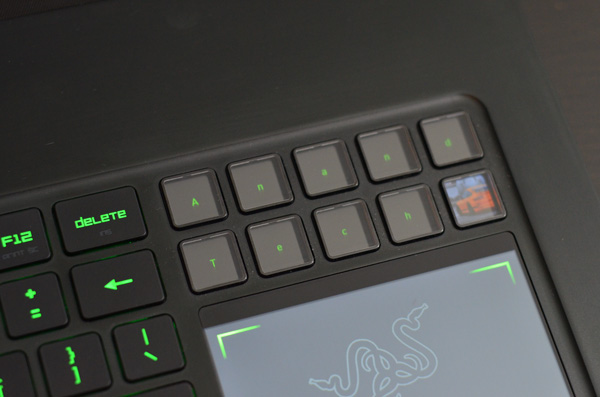

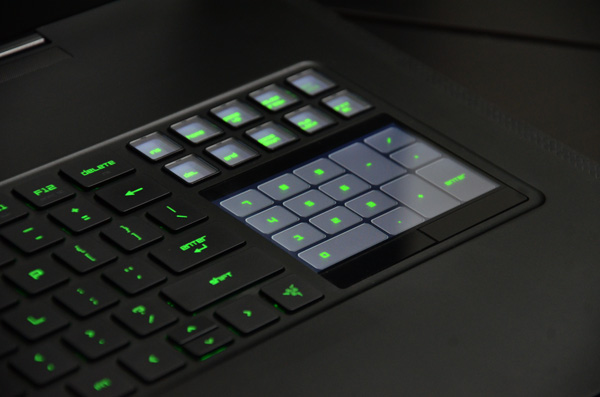
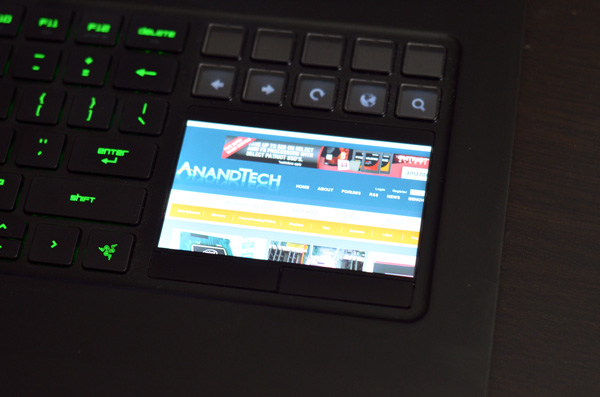
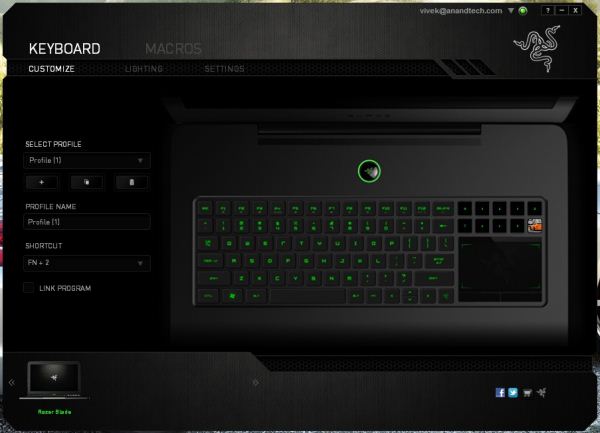
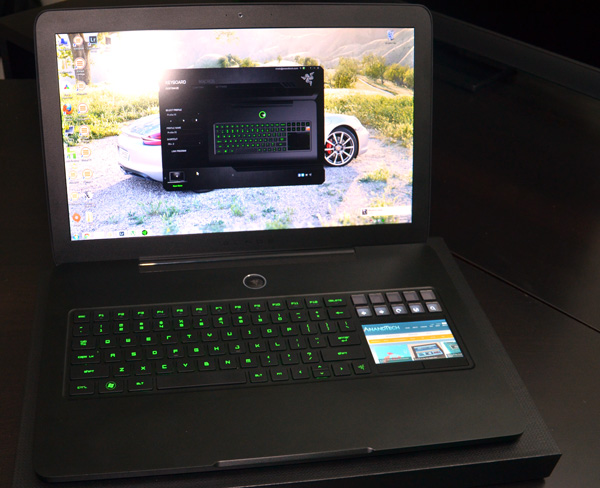








95 Comments
View All Comments
geniekid - Thursday, March 15, 2012 - link
I will echo the general sentiment that this thing is both overpriced and inadequate for gaming, but at the same time it's nice to see a company really try and increase the overall build quality of a laptop.The problem is when you take big risks like this you have to get it right the first time, or you have to have enough resources in reserve (and enough faith from the powers on high) to iteratively improve the product until it's good enough. I hope Razer gets into the latter category and succeeds.
kenyee - Thursday, March 15, 2012 - link
Cost unfortunately is too high. And what's with only 2 memory slots on a giant 17" laptop?The rest actually looks pretty cool. If Apple released something like this, their fanboys would be all over it, despite the price ;-)
Hopefully high res displays will drop in price and ivy bridge/kepler will make this a lot more interesting...
Felix_Ram - Thursday, March 15, 2012 - link
I can't help but think that Razer is out too early on the market, and that they have the wrong cpu company in their machine. Their concept is good, it's just not competitive enough.If they were launched with the coming AMD APU, the topline trinity, and they at the same time managed to crossfire the APU with an AMD GPU, without changing the machines design, they might have a much more competitive product on their hand.
JarredWalton - Thursday, March 15, 2012 - link
No way. Trinity very likely won't even be as fast as Sandy Bridge for CPU tasks, the APU graphics won't be as fast as a GT 555M by a long shot (about 33% slower I'd wager, though I could be wrong), and AMD's switchable graphics and dual graphics still has serious driver issues in my experience. You don't spend basically $1500 on the industrial design and build quality only to ship it with a slower CPU and GPU.VivekGowri - Friday, March 16, 2012 - link
Agree with the "too early to market", disagree with everything else. If they had waited a couple of months, this could have Ivy Bridge and Kepler, and they could have used the extra month or two to fix some of the more pressing stability issues that plagued Switchblade at launch. It's a bit of a pity that they didn't, actually.tonyn84 - Thursday, March 15, 2012 - link
I really, really like the form factor of this, I think moving the trackpad to the right side is brilliant (sorry lefties) and really hope to see this in future gaming laptops. The price though, I can't even get close to justifying for the performance. With any luck though they'll be able to have a couple different models at some point after ivy bridge is available. If they can get is closer to $1500 I'd seriously consider it, even with slightly less bells and whistles.Bees - Thursday, March 15, 2012 - link
What I'd like to know is why the facts that the keyboard and touchpad can both go unresponsive on their own wasn't treated in this review like the showstopping bugs they are. I've seen it firsthand with someone else's Blade, it's ridiculous that something so widespread (according to the support staff on the phone) made it past QC on such an expensive piece of tech.JarredWalton - Thursday, March 15, 2012 - link
I don't know if Vivek ever had this happen, but I certainly didn't encounter that problem in the several days of testing I did. Most likely it is a QC bug and your friend got bit, or else something else is going on. That said, I do not like the keyboard or touchpad at all. Vivek had more time to adapt so I left that to him to discuss, but I found the touchpad to be an expensive gimmick.IKeelU - Thursday, March 15, 2012 - link
Finally a company willing to invest in portability, good design and quality, that isn't called Apple. I would buy this without even thinking of it as a gaming laptop, if only they could reduce the noise level.Considering how many actually spend 2k+ on Macbooks, I'm astonished that it took a peripheral company to invent such a desirable high-end laptop. I hope this sells well, and I hope Dell, HP et al. take note.
FormulaRedline - Thursday, March 15, 2012 - link
This product is an early April fools joke, right? I saw "Gaming" and "1080p" followed shortly by "555m" and basically stopped reading. That is until I saw the almost $3k price tag...then I had to post.You can pretend Marketing screwed this up by claiming it to be a top of the line gaming product when it's really more a 17" ultrbook/MPB -like machine, but Razer is SUPPOSED to be high end gaming. 555m's belong in sub-$1000 machines that can do some gaming on the side at lower resolutions.
Meanwhile, it's got a great processor. Oh good, now we can bottleneck the @#*$ out of it. Has anyone at Razer ever even built a computer?